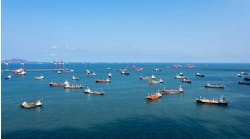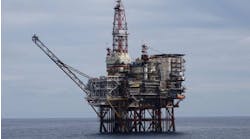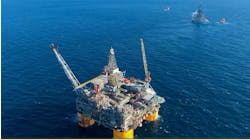Bruce Beaubouef • Houston
After a record-high year of production and exploration activity in 2009, results from 1Q 2010 were pointing toward another remarkable year for the deepwater Gulf of Mexico. However, the Macondo blowout on April 20 brought the region to a standstill. Immediately following the disaster, speculation on long-term implications sparked fear and uncertainty about the future GoM operating environment.
A year later, a new study by Wood Mackenzie says that the offshore industry is navigating the recovery process in earnest. The study, entitled “A year after Macondo: ongoing recovery for GoM operators,” finds that GoM operators and workers are eager to return to pre-Macondo activity levels, but are constrained by what they consider to be a cumbersome regulatory review process. Others, including environmentalists and government officials, contend that a total overhaul of the regulatory and safety environment is imperative to prevent future disasters.
Some of the key findings in the report include:
- 2011 deepwater GoM production is expected to decline by 375,000 boe/d, or 20% of previously estimated levels
- Production is not expected to exceed pre-Macondo levels until 2016
- A new permitting equilibrium will be reached in mid-2012
- Exploration activity is expected to return to pre-Macondo levels in 2013, across all plays
- The rig market in deepwater GoM is expected to remain steady in the medium-term
- Five fields have received sanction since the Macondo blowout, with an estimated $14 billion committed to deepwater GoM development
- During 2010, BP suffered 25,000 boe/d of production deferment related to the Macondo response and subsequent drilling moratorium. Further setbacks are expected in 2011-2013, with an average of 95,000 boe/d postponed each year
- The Macondo incident has impacted top GoM producers to different degrees, yet has compelled operators to review corporate strategy and future GoM activities.
The report reviews the regulatory response and corporate activities of the past year, and examines the strategies of several GoM operating companies.
Its final section, “lessons learned,” concludes that the Macondo blowout exposed weaknesses in both regulatory and safety operations. But it also points out that companies operating in the Gulf have remained steadfast and are prepared to do their part to prevent future disasters. The report also says that in the wake of the spill, the US government made hasty, politicized decisions and will suffer lost revenue for years to come, as a result.
In the short-term, Wood Mackenzie says it expects deepwater GoM exploration, development, and production levels to be constrained. But the reports also comments that the region has much to offer for those that can endure ongoing challenges.
GoM operators have historically pushed technological boundaries to extract production from deeper and more complex reservoirs. The increased development cost of Lower Miocene and Lower Tertiary plays will be partially alleviated by the stable US fiscal regime, which has facilitated growth and is attractive when compared to other deepwater basins. The report concludes that the Macondo blowout does not overshadow historical success, but will lead to a safer environment for future achievements.
ATP receives second deepwater permit
ATP Oil & Gas Corp. says it has received a permit to complete the previously drilled #2 well at Green Canyon (GC) block 300 in the deepwater GoM.
“We are pleased that the BOEMRE is confident in ATP’s commitment to safe and environmentally sound operations,” stated T. Paul Bulmahn, ATP’s chairman and CEO. “The Gulf of Mexico is where we refined our deepwater expertise and we are looking forward to generating further production growth.”
The GC 300 #2 well, in 3,454 ft (1,053 m) of water, was side tracked and encountered a gas reservoir between 15,590 ft (4,752 m) and 15,721 ft (4,792) TVD in 2006. ATP plans to commence well operations with Diamond Offshore’sOcean Victory in 2011. ATP operates GC 300 with a 55% working interest.
KBR awarded Jack & St. Malo contract
KBR says it has won a contract by Chevron U.S.A. Inc. to execute detailed design engineering for the Jack & St. Malo floating production unit (FPU) fed from the Lower Tertiary trend in the deepwater Gulf of Mexico. Jack and St. Malo are within 25 mi (40 km) of one another, approximately 280 mi (450 km) south of New Orleans, in water depths of 7,000 ft (2,100 m).
KBR will provide design and engineering support through fabrication for the deep-draft semisubmersible, including: hull, deck box, accommodations, appurtenances, equipment foundations; mooring system design; and anchor suction piles.
The semisubmersible will be designed to minimize vessel motion and allow acceptable fatigue lives of the moorings, risers, and umbilicals.
The award of this contract follows the successful completion of conceptual engineering and design, pre-FEED and FEED by KBR for the Jack & St. Malo FPU project.
Snapshot poll shows concern over post-Macondo regulation
Oil and gas industry professionals are concerned that post-Macondo regulation will have an adverse effect on their companies, according to a poll conducted at the recent SPE Offshore Technology Conference (OTC) 2011 in Houston. Some 61% of participants agreed when asked “Will post-Macondo regulation have a negative impact upon your business?”, while 39% felt an impending revision of industry regulation following last year’sDeepwater Horizon incident would not cause harm.
The poll was conducted by global independent technical advisor GL Noble Denton as part of its Industry Snapshot campaign, and was taken during the third day of OTC. It reflects the responses of a variety of professionals in the oil and gas industry, and highlights the sector’s cautious approach to the regulatory aftermath of the disaster.
“The potential impact of regulatory changes following the Macondo disaster continues to feature heavily in industry debate, more than a year since the incident took place,” said Dr. R.V. Ahilan, managing director of Advanced Engineering and Consulting at GL Noble Denton. “The result of (this) poll demonstrates that oil and gas professionals are concerned that tighter regulation will bring an increase in operating costs and less investment into other areas of business in turn.”
GL Noble Denton conducted three polls during OTC week, one for each full day of the show. On Monday, May 2, visitors were asked whether or not they expect the price of oil to reach $150 per barrel by the end of 2011, and the findings showed that the industry is evenly divided in opinion. Some 48% felt it would reach $150 per barrel; 52% felt it would not.
On Tuesday, May 3, sector professionals were asked if the industry is doing enough to avert an impending shortage of technical professionals. Some 72% of participants felt that not enough is being done to address the issue, while 28% felt that the industry is providing enough support to attract future technical talent.
Offshore Articles Archives
View Oil and Gas Articles on PennEnergy.com


